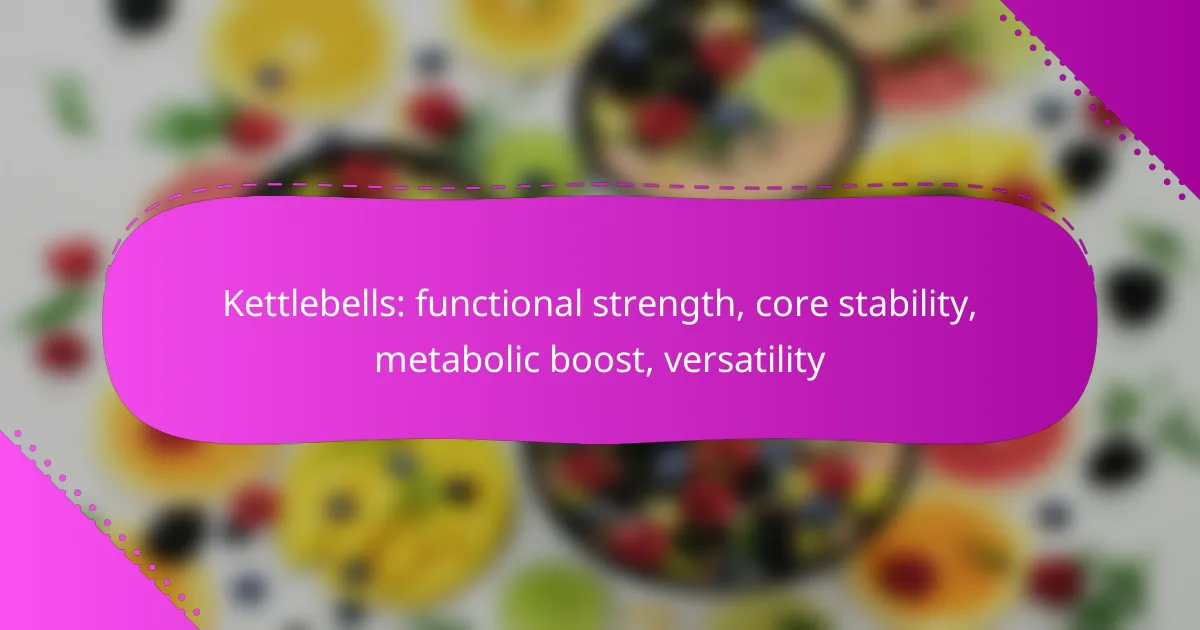Kettlebells are a powerful tool for enhancing functional strength, core stability, and metabolic conditioning. By engaging multiple muscle groups in dynamic movements, they not only improve overall physical performance but also promote better coordination and stability. Their versatility allows for high-intensity workouts that boost metabolism, making them an effective choice for anyone looking to elevate their fitness routine.

How do kettlebells improve functional strength?
Kettlebells enhance functional strength by engaging multiple muscle groups simultaneously, mimicking real-life movements. This type of training improves overall performance in daily activities and sports by building strength, coordination, and stability.
Full-body workouts
Kettlebell exercises often involve the entire body, making them efficient for building functional strength. Movements like swings, snatches, and cleans activate various muscle groups, promoting balanced development. Incorporating full-body workouts can save time while maximizing strength gains.
Dynamic movements
Kettlebells facilitate dynamic movements that require coordination and stability, such as the Turkish get-up or the kettlebell swing. These exercises not only build strength but also improve agility and flexibility. Practicing dynamic movements can enhance your ability to perform everyday tasks with ease.
Progressive overload
To improve functional strength with kettlebells, applying the principle of progressive overload is essential. Gradually increasing the weight or complexity of exercises challenges your muscles, leading to growth and adaptation. Start with a manageable weight and increase it as your strength improves, aiming for increments of 1-2 kg.
Core engagement
Kettlebell workouts inherently engage the core, as many exercises require stabilization throughout the movement. Strong core muscles support better posture and reduce the risk of injury. Focus on maintaining a tight core during lifts and swings to maximize strength benefits.
Increased muscle activation
Using kettlebells can lead to greater muscle activation compared to traditional weights due to their unique shape and design. The offset center of mass forces your muscles to work harder to stabilize during movements. Incorporating kettlebells into your routine can enhance muscle recruitment, leading to improved strength outcomes.

What are the benefits of kettlebells for core stability?
Kettlebells significantly enhance core stability by engaging multiple muscle groups simultaneously, particularly during dynamic movements. This leads to improved strength and control in the core, which is essential for overall physical performance and injury prevention.
Enhanced balance
Kettlebell training promotes enhanced balance by requiring the body to stabilize itself during various exercises. Movements like the kettlebell swing or Turkish get-up challenge your center of gravity, forcing your core and stabilizer muscles to work harder. This can translate to better balance in everyday activities and sports.
Improved posture
Using kettlebells can lead to improved posture by strengthening the muscles that support the spine. Exercises such as kettlebell deadlifts and overhead presses encourage proper alignment and engagement of the back and abdominal muscles. Consistent training can help counteract the effects of prolonged sitting and poor posture habits.
Strengthened stabilizer muscles
Kettlebell workouts effectively target stabilizer muscles, which are crucial for maintaining joint stability and overall movement efficiency. Exercises like the single-arm kettlebell row or overhead carry require these smaller muscles to engage, leading to better functional strength. Strengthening these muscles can help reduce the risk of injuries during physical activities.

How do kettlebells boost metabolism?
Kettlebells enhance metabolism primarily through high-intensity workouts that elevate heart rate and promote muscle engagement. This leads to increased caloric expenditure during and after exercise, making kettlebells a versatile tool for metabolic conditioning.
High-intensity training
High-intensity training with kettlebells involves performing exercises at a vigorous pace, which significantly elevates your heart rate. This type of training can include swings, snatches, and cleans, all of which require explosive movements that engage multiple muscle groups simultaneously. Incorporating these exercises into your routine can lead to improved cardiovascular fitness and greater metabolic rates.
Afterburn effect
The afterburn effect, or excess post-exercise oxygen consumption (EPOC), occurs when your body continues to burn calories after a workout. Kettlebell training, particularly at high intensities, can create a substantial afterburn effect, leading to additional caloric burn for hours post-exercise. This means that a 20-30 minute kettlebell session can result in increased metabolism long after your workout has ended.
Caloric burn during workouts
During kettlebell workouts, the caloric burn can vary based on intensity, duration, and individual factors like weight and fitness level. On average, a person can burn anywhere from 300 to 600 calories in a 30-minute kettlebell session. To maximize caloric burn, focus on compound movements and maintain a steady pace throughout your workout.

What kettlebell exercises enhance versatility?
Kettlebell exercises that enhance versatility include movements that engage multiple muscle groups and promote functional strength. These exercises not only improve overall fitness but also allow for a wide range of applications in various workout routines.
Swings
Kettlebell swings are a dynamic exercise that targets the hips, glutes, and core while also providing cardiovascular benefits. To perform a swing, stand with feet shoulder-width apart, hinge at the hips, and swing the kettlebell between your legs before thrusting your hips forward to swing it to shoulder height. Aim for 15-30 repetitions per set, focusing on form to avoid back strain.
Common pitfalls include using the arms instead of the hips for momentum and rounding the back during the swing. To maximize effectiveness, keep your core engaged and maintain a neutral spine throughout the movement.
Turkish get-ups
The Turkish get-up is a complex movement that builds strength, stability, and coordination. It involves transitioning from a lying position to standing while holding a kettlebell overhead, engaging multiple muscle groups throughout the process. Start with lighter weights, aiming for 3-5 repetitions on each side to master the technique before increasing the load.
This exercise requires attention to detail; ensure you maintain a strong grip on the kettlebell and move slowly through each phase. Avoid rushing, as this can lead to poor form and potential injury.
Goblet squats
Goblet squats are an excellent way to enhance lower body strength and core stability. Hold a kettlebell close to your chest with both hands, then squat down while keeping your back straight and chest up. Aim for 10-15 repetitions per set, ensuring your knees track over your toes and your weight is distributed evenly through your feet.
To avoid common mistakes, do not let your heels lift off the ground or your knees cave inward. Focus on depth; aim to squat as low as comfortable while maintaining proper form to maximize the benefits of this versatile exercise.

What should you consider when choosing kettlebells?
When selecting kettlebells, consider factors such as weight, material, handle design, and your fitness goals. Choosing the right kettlebell can enhance your workout efficiency and safety, making it essential to match the equipment to your personal needs.
Weight
Weight is a crucial factor when choosing kettlebells. Beginners typically start with weights ranging from 8 to 16 kg (18 to 35 lbs), while more experienced users may opt for heavier options, often between 16 to 32 kg (35 to 70 lbs). It’s important to select a weight that challenges you without compromising your form.
Consider your fitness level and the specific exercises you plan to perform. For instance, lighter kettlebells are better for high-rep workouts focused on endurance, while heavier weights are suitable for building strength with fewer repetitions.
Material
Kettlebells come in various materials, including cast iron, vinyl-coated, and competition-grade options. Cast iron kettlebells are durable and provide a traditional feel, while vinyl-coated kettlebells can protect floors and reduce noise. Competition kettlebells are uniform in size regardless of weight, which can help with grip and technique.
Choose a material that aligns with your workout environment and preferences. For home use, consider the noise and floor protection aspects, while in a gym setting, durability may be more important.
Handle Design
The handle design of a kettlebell affects grip and comfort during workouts. Look for a handle that is wide enough to accommodate both hands for various exercises. A smooth finish can help prevent chafing, while textured handles may provide better grip during intense sessions.
Test the handle before purchasing if possible. Ensure that it feels comfortable and secure in your hands, as this can significantly impact your performance and safety during workouts.
Fitness Goals
Your fitness goals should guide your kettlebell selection. If your aim is to improve functional strength and core stability, choose weights that allow for a mix of strength and endurance training. For metabolic boosts, consider lighter weights that facilitate higher repetitions.
Align your kettlebell choices with specific training programs or routines. For example, if you are focusing on explosive movements, you may want to select a lighter kettlebell to prioritize speed and technique over sheer weight.
